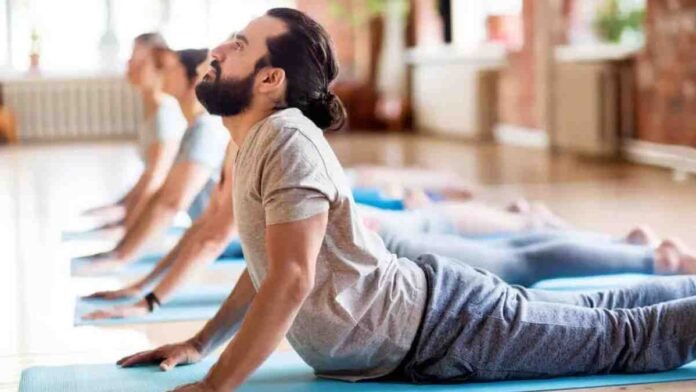Since high blood pressure can result in major illnesses like heart disease and stroke, maintaining appropriate blood pressure levels is essential for general health. Modifying one’s lifestyle to include regular exercise and stress-reduction strategies can greatly enhance cardiovascular health. In instance, yoga is a useful natural blood pressure management technique.
The Connection Between Yoga and Blood Pressure
Yoga lowers stress and encourages relaxation, both of which are critical for decreasing blood pressure. It calms the body by stimulating the parasympathetic nervous system with light motions and deep breathing. By encouraging mindfulness and assisting people in controlling their thoughts and emotions, this mind-body link also helps people maintain better blood pressure levels.
Effective Yoga Poses for Lowering
- Child’s Pose (Balasana)

Description: The peaceful resting position known as Child’s Pose, or Balasana, involves kneeling, sitting back on your heels, extending your arms forward, and bringing your forehead to the floor. This soothing stance is meant to encourage relaxation and looks like a toddler sleeping.
Benefits: Reduces Stress: Helps to relax the body and mind by stimulating the parasympathetic nervous system.
Reduces Fatigue: Offers a rejuvenating respite, replenishing vitality.
Encourages Relaxation: Promotes peace by releasing tension in the hips, shoulders, and back.
Promotes Mindfulness: Paying attention to one’s breathing and bodily sensations heightens awareness and lowers anxiety.
- Legs-Up-the-Wall Pose (Viparita Karani)

Description: Legs-Up-the-Wall Pose, also known as Viparita Karani, is a healing yoga pose in which you raise your legs against a wall while lying on your back. Sit close to a wall, lean back, and raise your legs to create a L shape as a way to practice. For five to fifteen minutes, keep your arms at your sides and take deep breaths.
Benefits: Enhances Circulation: Raising your legs improves blood flow to the heart, which is good for your heart.
Reduces Tension: This position promotes general relaxation by easing tension in the legs and lower back.
Calming Effect: It lowers stress hormones and relaxes the neurological system, which helps reduce blood pressure.
awareness: During the position, pay attention to your breathing to promote awareness and reduce blood pressure.
Gentle Stretch: This technique stretches the lower back and hamstrings gently without putting undue strain on the body.
- Corpse Pose (Savasana)

Description: Lying flat on your back with your arms at your sides, palms facing up, and your legs outstretched is known as Savasana, or Corpse Pose. Usually performed at the conclusion of a yoga practice, this posture encourages quiet and focus.
Benefits: Deep relaxation promotes the body’s release of stress, both mental and physical, which facilitates healing.
Stress relief lowers anxiety and heart rate by calming the neurological system.
The mind-body connection fosters inner tranquility by raising consciousness of ideas and sensations.
Blood Pressure Management: Naturally lowers blood pressure by promoting calmness and lowering stress hormones.
- Cat-Cow Stretch (Marjaryasana-Bitilasana)

Description: The Cat-Cow Stretch is a dynamic yoga exercise that alternates between the rounded Cat and arched Cow poses. Start on your hands and knees.
Cat Pose: Inhale and arch your back up, tucking your chin into your chest.
Cow Pose: Exhale and lower your tummy while rising your head and tailbone to the ceiling.
Benefits: Improves Flexibility: Promotes spinal mobility with mild extension and flexion.
Tension Release: Reduces back and neck tension, resulting in improved posture.
Improves Circulation: Increases blood flow to the spine and surrounding muscles.
Promotes Mindfulness: Increases breath awareness, which helps to alleviate stress.
- Bridge Pose (Setu Bandhasana)

Description: To do Bridge Pose, lie on your back, knees bent and feet flat on the floor, hip-width apart. Press your feet into the mat and raise your hips to the ceiling, activating your glutes. You can keep your arms at your sides or clasp them behind your back for support. Hold the position for 30 seconds to a minute, inhaling deeply, before slowly lowering your hips to the mat.
Benefits: Opens the Chest: Stretches the chest and shoulders to improve posture.
Improves Blood Flow: Lifting the hips increases circulation, which can help decrease blood pressure.
Relaxation: Promotes deep breathing and stress release.
Strengthens the Core and Back: Engages and strengthens important muscle groups, promoting overall stability.
Conclusion
Incorporate these yoga positions into your regular practice to naturally improve heart health and reduce blood pressure. Always see a healthcare practitioner before beginning, especially if you have any preexisting medical issues.




